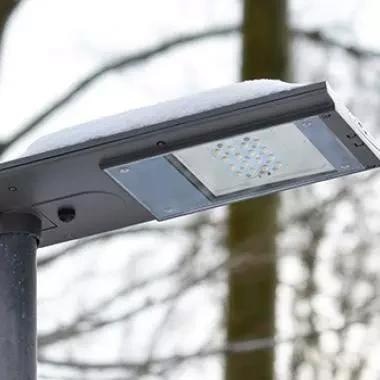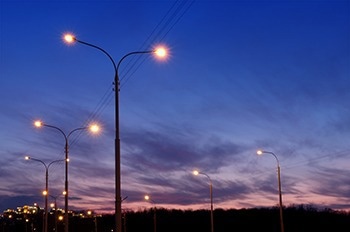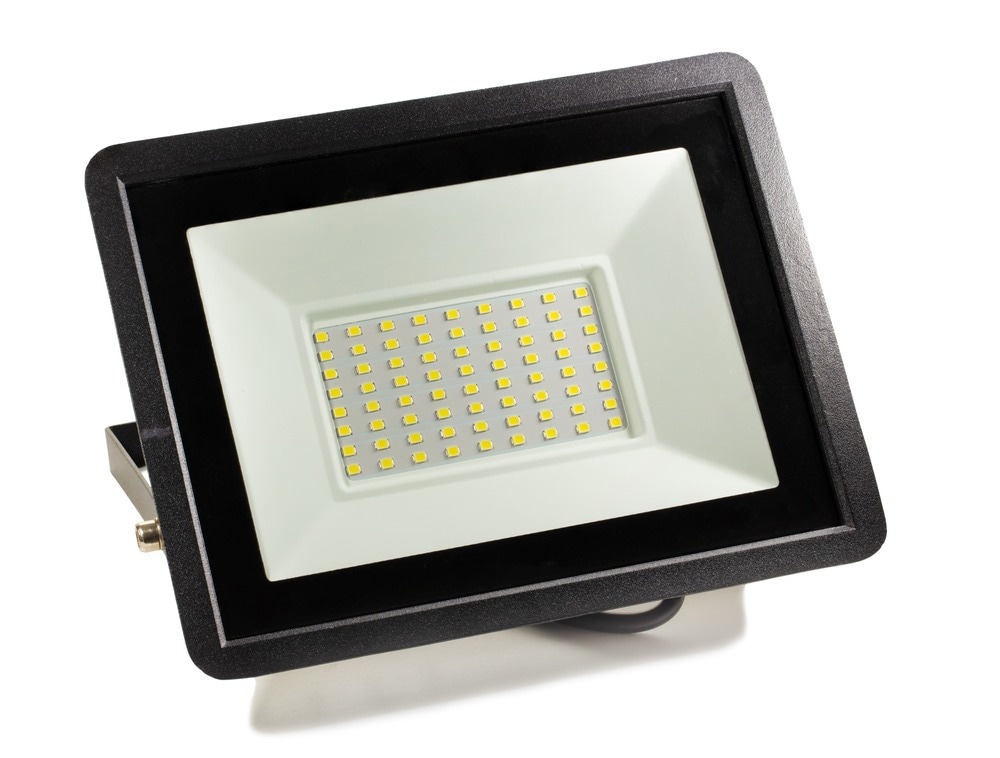LED lighting technology offers numerous advantages, including high energy efficiency, exceptional durability, and a long lifespan, making it an ideal choice for various applications.

Image Credit: Saint-Gobain Tape Solutions
LED lighting technology is increasingly adopted for its energy efficiency, durability, and longevity, making it an ideal solution for modernizing urban areas and developing smart city infrastructures.
With global demand for energy-efficient systems rising, LEDs are gaining traction in outdoor spaces, such as building exteriors, highways, and public areas.
LEDs have become an ideal solution for low-maintenance lighting needs, particularly for powering digital signage, and electronic displays and illuminating large spaces, such as parking lots and recreation areas. LEDs are gaining ground in outdoor areas, including building exteriors and highways.

Rows of lit street lamps at dusk. Image Credit: Shutterstock/white snow
The longevity and durability of LED technology make them highly valuable in remote or hard-to-reach locations. In addition to their durability and energy efficiency, LEDs are often favored over other light sources for their flame retardancy and low outgassing properties.
Their color rendering capabilities and programmability make them an ideal choice for creating visually stunning displays in various applications, from the bright lights of the Las Vegas Strip to the world’s tallest performing fountain in Dubai.
Although LED deployment costs can be initially higher than traditional lighting, the resulting power savings and reduced replacement expenses will likely outweigh these costs in the long run.
However, the LED benefits mentioned above may not hold if the investment is not safeguarded. For outdoor LED installations, it is crucial to ensure resilience against ever-changing environmental conditions.
In numerous parts of the world, harsh winter cycles pose a significant threat to outdoor LED installations as they are exposed to them repeatedly throughout their long service life. It is crucial to safeguard against changing environmental conditions, even in warmer climates, given the increasing volatility of the global environment.
Role of Gaskets
Outdoor LED applications typically involve LED bulbs encased in glass and fitted into a metal outer casing.
Gaskets provide cushioning and protection between the bulbs and the casing. Various materials are available for gaskets designed to act as a buffer against common environmental stressors, such as rain, snow, dust, and sunlight. These materials include PVC plastic, EPDM, neoprene rubber, and more.

Gaskets are employed to provide both protection and cushioning for LEDs. Image Credit: Shutterstock/Andrew Mayovskyy
AWith Greater Environmental Volatility, However, Come Greater Challenges
- Deterioration and Shorter Shelf Life: Engineers need to consider environmental trends, such as greater exposure to ultraviolet (UV) rays, extreme heat, and wildfires, as well as the intensity of windstorms, rainstorms, and snowstorms when selecting gasket materials. These factors can lead to faster deterioration and shorter shelf life for gaskets, resulting in the need for more frequent replacement of the LEDs they are intended to safeguard.
- Maintenance Costs: Choosing lower-cost gasketing materials to reduce upfront expenses may lead to higher maintenance costs in the long run.
- Lighting Failures and Dangerous Conditions: Gasketing materials for LEDs used in outdoor applications are critical for ensuring safety in areas such as building entrances and exits, parking lots, and streetlights. The inability to withstand environmental extremes of the gasketing materials may result in lighting failures leading to dangerous conditions for end-users, such as accidents, slips, falls, or vehicle collisions. Engineers specifying protective materials would be responsible for the liability associated with these risks.
Silicone Protection: A More Forward-Thinking Approach
Investing in premium gasketing materials can provide a more forward-thinking approach to protecting LED installations.
Silicone is a suitable gasket material for LED applications due to its durable nature and inherent properties such as high tensile strength and excellent thermal stability.
Moreover, silicone's low compression set enhances its ability to protect and cushion the LEDs compared to other elastomers.
Taking a forward-thinking approach, Saint Gobain’s high-quality Norseal® silicone materials are available in various foam rubber, sponge rubber, and Strip-N-Stick (SNS) tape products.
The foam and sponge rubber products offered by Norseal® are designed to provide reliable service for at least 10 years, with various options available for different applications.
These products are thoroughly tested for suitability as gasket materials, meeting industry standards such as UL-50, UL-50E (recognized as a weather seal gasket), UL V-0, and JMLU2.
The low outgassing quality of the products is achieved through a proprietary post-curing process. This quality reduces the tendency of gasketing materials to produce condensation, which not only enhances the aesthetics but also improves the safety of fixtures intended for dimly lit areas.
Using gasketing materials with low outgassing quality ensures better brightness and clarity of illumination, ultimately resulting in a more efficient lighting system. The benefits of silicone gasketing are particularly noticeable in the face of environmental volatility.
The resilience of silicone gasketing is most evident in environmental volatility due to its ability to withstand extreme temperatures, resistance to fungus growth, and long-term protection against dirt, moisture, sunlight, ozone, and UV rays.
These qualities exemplify characteristics that enable silicone gasketing to endure a changing world.
Meeting User Needs
The Norseal silicone line offers products specifically designed to meet the unique requirements of end users. For example, the foams are ideal for use as lightweight gaskets, and they are non-corrosive when used with metals, making them well-suited for use in unpredictable environments.
Sponges are an ideal option for applications that require continuous operation, such as gas station lighting, thanks to their remarkable thermal stability. Sponges offer low water absorption, making them an excellent choice for high-humidity environments.
Tapes provide the flexibility to conform to irregular services and shapes, and they can reduce overall lighting structure costs when used in place of expensive die-cut parts. Here are some selected specifications for Norseal products across all form factors, including foams, sponges, and tapes.
These products have been designed with specific requirements in mind, such as low toxicity and flame retardancy, which are especially important in public spaces and mass transit applications:
Silicone Foam Rubber
Norseal offers F-12 and F-20 silicone foams that are lightweight and soft with low and medium density, respectively. These products provide exceptional resistance to compression sets and feature outstanding flame resistance (UL94 V-0). They exhibit low toxicity and smoke generation.
Silicone Sponge Rubber
Norseal R10480 and 10480S possess outstanding mechanical strength and thermal stability. They exhibit an exceptionally low compression set, negligible outgassing, and excellent resistance to ozone and UV.
These products effectively prevent water penetration into the LED electrical components. It is worth mentioning that Norseal R10480 and 10480S are UL-50E recognized.
SNS Foam Tapes
Norseal SNS100S and 200A tapes provide the benefits of silicone rubber in a user-friendly, pressure-sensitive adhesive tape format, backed by a closed-cell sponge.
The SNS100S variant features a silicone adhesive with a wide temperature range on one side, whereas the 200A variant offers an aggressive acrylic adhesive.
Norseal 512GF and 520GF are pressure-sensitive adhesive tapes that offer the advantages of silicone in an easy-to-apply form, backed by flame-retardant silicone foam (UL94 V-0 for based foam).
The 512GF variant utilizes F-12 foam with a film-supported acrylic adhesive, while the 520GF variant uses F-20 foam with a film-supported acrylic adhesive.
ThermaCool® Coated Fabrics TF1860 and 1870 Series are part of the thermally conductive product line and are viable options for use in commercial outdoor lighting applications.
These products efficiently dissipate heat away from hot components that are generated by LED lighting, ensuring optimal performance and longevity.
In addition to the existing product line, Saint Gobain is committed to developing customized solutions to meet specific functional and aesthetic requirements.
Saint Gobain ensures that these tailor-made solutions take into consideration the anticipated environmental conditions and expected wear over the product's life expectancy.
Protect Investments of Today to Build Future Resiliency
With the energy efficiency and extended service life that LEDs offer, their increasing prominence in the lighting industry comes as no surprise.
However, it is imperative to acknowledge that the world is constantly evolving, which presents a challenge when it comes to investing in LED technology.
Premium gasketing materials, such as Norseal silicones, are designed to meet or exceed specifications that are specifically tailored to address environmental volatility. Unlike lower-cost elastomers, these materials are engineered to provide superior performance and longevity.

This information has been sourced, reviewed and adapted from materials provided by Saint-Gobain Tape Solutions.
For more information on this source, please visit Saint-Gobain Tape Solutions.